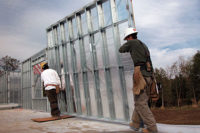As I think about the words of the Italian diplomat Niccolò Machiavelli, “Never waste the opportunity offered by a good crisis,” I can’t help but think how that relates to us today. Eighteen months ago, we were all staring into the abyss of the COVID shutdown and none of us were certain how deep or wide the chasm would be. There was a short-term sigh of relief when many states and jurisdictions deemed construction an essential activity. However, we’re still dealing with the supply chain hangover from the shutdown of manufacturing plants, lumber mills, trucking and suppliers that are, themselves, essential to construction.
Along with delays in getting construction materials, we’ve seen dramatic gyrations in prices. And just as it seemed there was light at the end of the tunnel this spring, along came Delta.
We’ve Been Here Before
In many (non-pandemic) ways, this industry has been here before. It looked different but it was just as scary for a time. If we’re paying attention, this current crisis can be seen as an opportunity to apply some important earlier lessons that will ensure our businesses exit this period running more efficiently, and more competitively, than ever.
This all occurred to me as I was looking through files from almost two decades ago. I ran across an industry analyst’s graphic depiction of the movements of steel price and availability over a 20-year period. It started with a drawing of a snake to indicate the slight up and down movements of steel supply in the decades up until the mid-1990s.
That’s when the drawing got interesting. In June 1994, the line on the chart shot almost straight upward to a picture of a volcano—a visual metaphor of what at the time must have felt like a shock to the industry. Over the subsequent 10 years, the line transformed from the smooth undulations of the pre-1990s to something more akin to a ride on an old wooden roller coaster with loose wheels. The line shooting up to the volcano was followed by a steep plunge described by the author as a “death spiral.” This was followed by another big volcano, another death spiral, a trip through “Death Valley” on the way to a mini volcano, then another death spiral that led to a volcano, then more wild gyrations before the last point on the timeline in 2006.
With all that drama, I’m surprised we all survived. But survive we did. And anyone who was along for the ride learned some important lessons that have helped them get through the worst of the current disruptions in the construction markets.
Lesson One: Manage Your Cash Flow
Inattention to cash flow management can cause a raft of problems for any contractor, but the material delays and price spikes in today’s market put a spotlight on measures that should be considered standard operating practice.
Lesson Two: Fix Your Contracts
There are some important provisions your attorney should make sure are part of your project contract template. Force Majeure provides protection in the event of a major disruption. The Escalation Clause allows for the adjustment of charges due to significant unexpected changes to materials costs. Mobilization Costs, or the cost of starting a project, may be incurred by the contractor several times in the event that conditions require work to be stopped, and re-mobilized again. A Termination Clause helps protect all parties by establishing a common understanding of how the work will be performed and, if necessary, how to walk away.
Lesson Three: Stay Close to Your Suppliers
They know where resources are plentiful, and where they are tight, which can be essential to proactively calibrating the construction schedule if needed. They can also help verify price changes if necessary.
Lesson Four: Communicate With Your Customers
While delays and price hikes have had plenty of coverage this year, your customers may not be aware of them until they’re directly affected. Make sure they have some awareness of the challenges in the market today, and don’t overpromise on cost or deadlines. If there are delays, be realistic when rescheduling.
Lesson Five: There’s Usually Good News on the Horizon
While the road to recovery has been longer than many of us thought, there is promising news to be found. Unlike the great recession, there is a lot of liquidity in the system that is available for funding the backlog of projects that have been sidelined.
There are also signs that the kinks in the supply chain are starting to untangle. Steelmaking capacity utilization by U.S. producers is at its highest level in more than a decade as the steel industry pushes to meet incredible demand. As a result, shipments of steel have returned to pre-pandemic levels following the strictest pullback since 2009.
More of this steel volume is finding its way to construction applications as a semiconductor shortage is curtailing demand in automotive applications. As urgent as the issues created by COVID crisis are, we have been here before. And we will be here again someday in some way, shape, or form. The question for each of us is whether this experience has prepared us for the next crisis, or will it be an opportunity gone to waste?






Report Abusive Comment